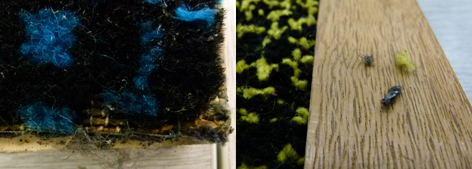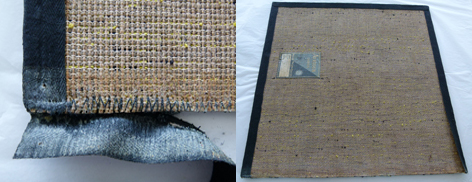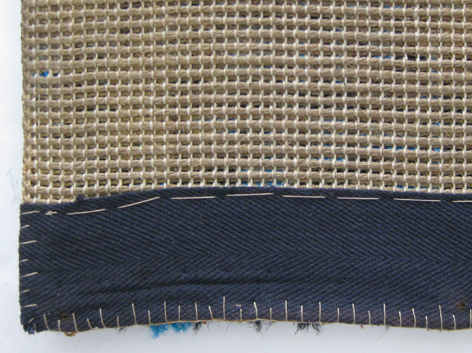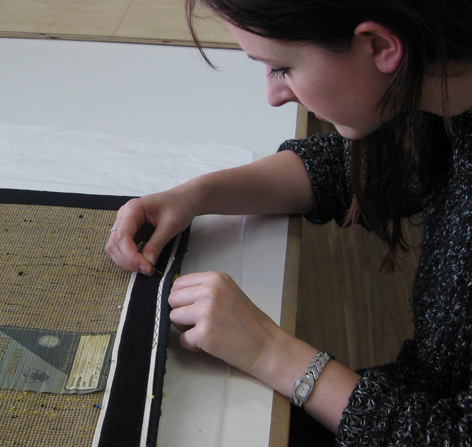A guest entry
Before I head off on a spot of annual leave, I have a bit of a treat for everyone – my very first ‘guest entry’ on this blog. In an earlier entry I wrote about the carpet samples in our collection that were going to be conserved at Zenzie Tinker Conservation. Emily Austin, a Textile Conservation student at the University of Glasgow, was completing a placement with Zenzie during June and got to work on our carpet samples. She very kindly agreed to write a blog entry about the processes and allow me to use her images for illustration. So here it is – parting ways with paper for a change!

“Recently while on a summer work placement at Zenzie Tinker’s Conservation studio, I was fortunate enough to be able to carry out the conservation treatment for two 1950’s carpet samples from the University of Brighton Design Archives.

When the carpet samples arrived it was clear that at some point they had been host to a large number of moths, no doubt attracted by the rich wool pile. The true extent of the infestation was realised once the metal tacks had been removed from the wooden boards on which the samples were mounted, revealing numerous moth casings. However, this also revealed the original manufacturing label on the yellow and black sample, shown in the image below. The samples were then prepared for freezing by sealing them in plastic sheeting; they were frozen for 72 hours at -30c to stop any live moth activity.

Once the samples were removed from the freezer, they needed to be thoroughly surface cleaned to remove any remaining moth casings and frass (debris), which involved carefully working through the carpet pile with a low suction vacuum and tweezers. There were large amounts of casings especially on the black and blue sample, as well as areas where the pile had been completely eaten away. Interestingly, the moths seemed to focus mainly on the yellow areas of pile in this sample, perhaps because of a particular dye or treatment used on this wool.

During this process, it became apparent that the cotton tape stitched around the raw carpet edges was preventing the full removal of the moth frass, as well as containing failing adhesive which had become yellow and powdered. Therefore, it was decided to replace the old tape and change the large mismatched stitching with a more suitable colour thread spaced closer together.

Following discussions with Design Archives’ staff, the carpets were then prepared for mounting onto fabric covered boards. This involved the stitched attachment of Velcro strips to the top and bottom of each sample giving an even distribution of weight once they are mounted. Currently, the light weight polycarbonate and sealed plywood-faced boards are being covered and once completed they will also have Velcro attached to support the carpet pieces.

Overall, the treatment has greatly improved the appearance and stability of the carpet samples, which were in poor condition when they arrived at the studio. This has not only been important for the future study of the samples at the University of Brighton Design Archives but it has also been a great experience for me as I continue my Textile Conservation training at The University of Glasgow.”

So there we are – I am picking up the finished carpet samples tomorrow. I visited the studio a few weeks ago where I could already see vast improvements in their condition, so I am very much looking forward to bringing them ‘home’.
